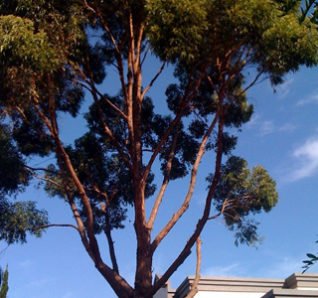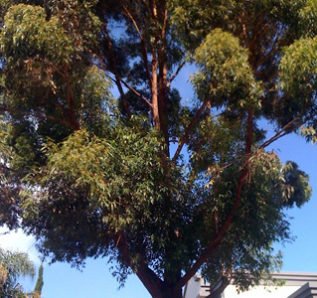Tree Trimming Sydney North Shore
Tree trimming is another name used to describe tree pruning, they mean exactly the same thing although the latter is the more scientific terminology. Our Sydney North Shore tree trimming arborists provide all forms of tree pruning techniques to ensure we can maintain trees for our clients in a safe and healthy condition whilst also providing the amenity values they require. Tree trimming in Sydney North Shore carried out by Sydney Tree Solutions is always done using qualified arborists and to the highest arborist industry standards. The Sydney tree services we provide are always carried out according to council regulations and we have a great reputation with all council tree officers and arborists across Sydney and the Sydney North Shore. One of the tree trimming techniques commonly used by our Sydney North Shore arborists is tree canopy thinning. Many of our Sydney clients would like to have increased solar access through the tree canopy since their rear yards are often very dark when underneath a large canopy tree. Since in most cases of tree trimming in Sydney North Shore it is not possible to get council approval to reduce the height of trees we can instead achieve this through tree canopy thinning techniques. This form of tree pruning maintains the overall size of the tree and the main structural branches but it removes some of the smaller branches to allow more light to penetrate. These tree services are very technical forms of tree trimming and can only be carried out by experienced, knowledgeable and skilled arborists to ensure the tree form and future growth is not compromised. Further details of the tree services and tree trimming in Sydney North Shore carried out by Sydney Tree Solutions is detailed below.
What is Tree Canopy Thinning ?
Tree canopy thinning or what is also called ‘Tree crown thinning’ is the terminology used to refer to the pruning of some of the smaller internal branches throughout the canopy to provide either increased solar or wind penetration through the canopy. In most cases this is for solar penetration and therefore more for the benefit of the client than the tree but there are also cases where the tree can benefit as well.
The overall size (i.e canopy height and canopy width) remains the same from this form of tree pruning but the internal branches are reduced. In this respect it would not often be termed ‘tree canopy reduction’ since that normally refers to the height and width of the canopy.
Tree canopy thinning is one of the most specialised forms of tree pruning that is performed by arborists and should only be performed by experts since it can create more problems than prior to the tree pruning if it is not carried out correctly
What are the Tree Canopy Thinning benefits ?
Tree canopy thinning can provide a number of benefits to both the tree and the owner of the tree, these are listed below:
- Increased solar access – this is the main benefit to the owner of the tree and is predominantly the reason why much of the tree pruning works to thin the canopy of trees is carried out. Expert arborists can greatly increase the amount of sunlight that can penetrate through the canopy of the tree whilst ensuring the tree canopy is still structurally sound. The percentage of the tree canopy that can be pruned is greatly dependent on the particular species of tree and sometimes may take a few repeat visits over the years to get the desired effect.
- Decreased wind loading to prevent failures during storm events – this can be effective with some tree species since it reduces the sail effect of large canopies that let very little throughflow of wind. The application of pruning for this reason is again dependent on the tree species and also strong consideration needs to be taken for the biomechanics of the tree so this can only be carried out by professional and highly trained arborists.
- Increased throughflow of wind – this may be required to reduce the build-up of certain fungal diseases inside the canopy during winter months.
- Tree pruning for removal of epicormic growths inside the tree canopy.
- Remedial pruning works to remove small crossing and defected branches inside the canopy.
How do you carry out Tree Canopy thinning ?
Tree pruning to thin the tree canopy is called ‘tree canopy thinning’ or sometimes called ‘tree crown thinning’. This is a very specialised task that needs to be carried out by professional experienced arborists to ensure the desired benefits are achieved without impacting the structural integrity of the tree and its future growth.
Over pruning of limbs to remove all the smaller internal branches and just leave the foliage at the tips, sometimes referred to as “lions tailing”, can seriously impact the stability of that limb during high wind events. The lower and internal branches are required to ensure the limb maintains its biomechanical stability and without this branch failures will become more likely.
Similarly tree canopy thinning or tree crown thinning that results in a large percentage of the overall canopy being removed can then cause the tree to produce lots of new epicormic growths along its branches since the tree needs to photosynthesise to produce the sugars it needs to survive.
Over pruning of the canopy in this way will then create an even denser canopy or crown that prior to the pruning works taking place originally. This problem is then permanently present for that tree meaning that the desired effect of the tree canopy thinning has not only been lost but is even worse than prior to the tree pruning event in the first place.
Therefore it is essential that tree canopy thinning or tree crown thinning is carried out only by experienced and highly skilled arborists, according Australian pruning standards of amenity trees and to the specifications provided by the council approval, to prevent your tree being irreversibly damaged.
Will a tree die if you cut the top off?
Tree pruning to remove the top section of the canopy, or crown, often termed “lopping” will not kill the tree but in most species of tree, particularly native species, it will cause the regrowth to create defective structural forms that can cause future safety issues from failures.
Although it is possible to do some forms of tree crown reduction, it needs to be done by a very experienced arborist to ensure these future defective tree forms (i.e. epicormic growths) are not created. In many species it is simply not possible to prevent these defective forms from growing back from trees that have been ‘lopped’.
For these reasons it is actually illegal in all North Shore Sydney Council areas to cut the top of all tree species with the exceptions of hedging species such as conifers. Full details of these pruning regulations can be found in AS-4373-Prunity of Amenity Trees.
Does cutting branches kill a tree?
Tree pruning and cutting of branches doesn’t not kill the tree but it should always be done by a professional arborist and in accordance with AS-4373-Prunity of Amenity Trees to ensure the tree can retain its correct structural form and health.
In most cases it is not advisable to prune more than 10% from the tree canopy per annum. All Sydney Tree Solutions arborists are experts at advising our North Shore Sydney Tree Pruning clients exactly how much pruning can occur to ensure these conditions are met.
How much does it cost to prune a tree ?
The cost of pruning a tree in the Sydney North Shore or greater Sydney area is a very common question we get from our clients and they often think there is a simple answer or that its mainly to do with how big or tall the tree is but it actually comes down to a variety of factors that in combination determine how long the works will take, what machinery is required, and the skill levels and number of personnel necessary to do the tree pruning works safely and professionally. The price to prune a tree depends on a huge variety of factors but primarily it can be determined by 3 main considerations:
- SIZE – How big is the tree – Height, Canopy width
- DIFFICULTY – Complexity of pruning process? – Complex rigging, Safety, Site factors
- ACCESS – Access from tree to road where truck and mulcher is parked.
With over 20 years of experience pricing Sydney tree pruning jobs our arborists can give you expert advice on how it is best to prune a tree for its safety and also to reduce the maintenance costs that may be required. The prices get much cheaper if doing more than 1 tree on the same site.
What areas do we cover with our Sydney tree removal services ?
Sydney Tree Solutions offers tree pruning and removal services in the greater Sydney area although the majority of our customers are within the Sydney North Shore. We serve areas like Killara, St Ives, Gordon, Turramurra, Wahroonga and Hornsby in the North Shore. Other areas we provide our tree services are Castle Cove, Willoughby, Artarmon, Lane Cove, Cammeray, Mosman, Chatswood, and Castlecrag in the Lower North Shore.
Inner West Sydney
Northern Suburbs
- Beecroft, Carlingford, Cheltenham, Cherrybrook, Denistone, Denistone East
- Denistone West, Dundas, Dundas Valley, East Ryde, Eastwood, Epping
- Ermington, Gladesville, Henley, Hunters Hill, Huntleys Cove, Huntleys Point
- Macquarie Park, Marsfield, Meadowbank, Melrose Park, North Epping, North Ryde
- Normanhurst, Pennant Hills, Putney, Ryde, Telopea, Tennyson Point
- Thornleigh, West Pennant Hills, West Ryde, Westleigh, Woolwich
North Shore
- Upper North Shore
- East Killara, East Lindfield, Gordon, Hornsby Shire, Killara, Lindfield
- Mount Kuring Gai, Pymble, Roseville, Roseville Chase, St Ives, South Turramurra
- Turramurra, Wahroonga, Waitara, Warrawee, West Pymble
- Lower North Shore
- Artarmon, Cammeray, Castle Cove, Castlecrag, Chatswood, Chatswood West
- Cremorne, Cremorne Point, Crows Nest, Greenwich, Kirribilli, Lane Cove
- Lane Cove West, Lavender Bay, Linley Point, Longueville, McMahons Point
- Middle Cove Milsons Point, Mosman, Naremburn, Neutral Bay, North Sydney
- Northbridge, Northwood, Riverview, St Leonards, Waverton, Willoughby
- Willoughby North, Wollstonecraft, Woolwich
Northern Beaches
- Manly
- Balgowlah, Balgowlah Heights, Clontarf, Fairlight, Manly, Seaforth
- Warringah
- Allambie, Allambie Heights, Beacon Hill, Belrose, Brookvale, Collaroy
- Collaroy Plateau, Cromer, Curl Curl, Davidson, Dee Why, Forestville
- Frenchs Forest, Freshwater, Killarney Heights, Manly Vale, Narrabeen, Narraweena
- North Balgowlah, North Curl Curl, North Manly, Oxford Falls, Queenscliff, Terrey Hills
- Pittwater
- Avalon, Bayview, Bilgola Plateau, Church Point, Clareville, Elanora
- Ingleside, Newport, North Narrabeen, Mona Vale, Palm Beach, Warriewood
- Whale Beach
Hills District
- Baulkham Hills, Beaumont Hills, Bella Vista, Carlingford, Castle Hill, Cherrybrook
- Dural, Galston, Glenhaven, Glenorie, Glenwood, Kellyville
- Kellyville Ridge, Kenthurst, Kings Langley, North Rocks, Pennant Hills, Quakers Hill
- Round Corner, Rouse Hill, Seven Hills, Stanhope Gardens, Thompsons Corner, The Ponds
- West Pennant Hills, Winston Hills
Forest District
- Belrose, Davidson, Duffys Forest, Frenchs Forest, Forestville, Killarney Heights
- Oxford Falls, Terrey Hills
Eastern Suburbs
Do I need my council permission?
There are often several exempt tree pruning and tree removal works that can be done without council approvals but you may need to have council permission if the work is outside the scope of tree pruning as prescribed by the Council Tree Preservation Order. The council arborists will need to check the tree and the site to determine whether you will need permission or not. Our professional north shore Sydney arborists can also advise you on when council permits are required for Sydney tree removal and tree trimming works.


